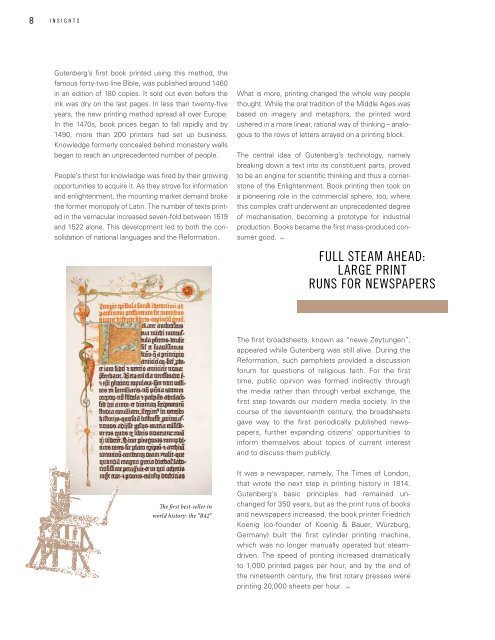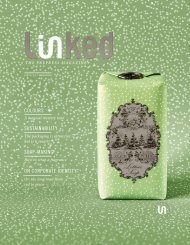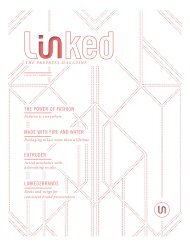You also want an ePaper? Increase the reach of your titles
YUMPU automatically turns print PDFs into web optimized ePapers that Google loves.
8 i n s i g h t s<br />
Gutenberg’s first book printed using this method, the<br />
famous forty-two line Bible, was published around 1460<br />
in an edition of 180 copies. It sold out even before the<br />
ink was dry on the last pages. In less than twenty-five<br />
years, the new printing method spread all over Europe.<br />
In the 1470s, book prices began to fall rapidly and by<br />
1490, more than 200 printers had set up business.<br />
Knowledge formerly concealed behind monastery walls<br />
began to reach an unprecedented number of people.<br />
People’s thirst for knowledge was fired by their growing<br />
opportunities to acquire it. As they strove for information<br />
and enlightenment, the mounting market demand broke<br />
the former monopoly of Latin. The number of texts printed<br />
in the vernacular increased seven-fold between 1519<br />
and 1522 alone. This development led to both the consolidation<br />
of national languages and the Reformation.<br />
What is more, printing changed the whole way people<br />
thought. While the oral tradition of the Middle Ages was<br />
based on imagery and metaphors, the printed word<br />
ushered in a more linear, rational way of thinking – analogous<br />
to the rows of letters arrayed on a printing block.<br />
The central idea of Gutenberg’s technology, namely<br />
breaking down a text into its constituent parts, proved<br />
to be an engine for scientific thinking and thus a cornerstone<br />
of the Enlightenment. Book printing then took on<br />
a pioneering role in the commercial sphere, too, where<br />
this complex craft underwent an unprecedented degree<br />
of mechanisation, becoming a prototype for industrial<br />
production. Books became the first mass-produced consumer<br />
good.<br />
Full steam ahead:<br />
large print<br />
runs for newspapers<br />
The first broadsheets, known as “newe Zeytungen”,<br />
appeared while Gutenberg was still alive. During the<br />
Reformation, such pamphlets provided a discussion<br />
forum for questions of religious faith. For the first<br />
time, public opinion was formed indirectly through<br />
the media rather than through verbal exchange, the<br />
first step towards our modern media society. In the<br />
course of the seventeenth century, the broadsheets<br />
gave way to the first periodically published newspapers,<br />
further expanding citizens’ opportunities to<br />
inform themselves about topics of current interest<br />
and to discuss them publicly.<br />
The first best-seller in<br />
world history: the “B42”<br />
It was a newspaper, namely, The Times of London,<br />
that wrote the next step in printing history in 1814.<br />
Gutenberg’s basic principles had remained unchanged<br />
for 350 years, but as the print runs of books<br />
and newspapers increased, the book printer Friedrich<br />
Koenig (co-founder of Koenig & Bauer, Würzburg,<br />
Germany) built the first cylinder printing machine,<br />
which was no longer manually operated but steamdriven.<br />
The speed of printing increased dramatically<br />
to 1,000 printed pages per hour, and by the end of<br />
the nineteenth century, the first rotary presses were<br />
printing 20,000 sheets per hour.









